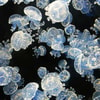Ecosystems & Restoration 135-ch55-slides PDF
Document Details

Uploaded by RapturousGyrolite5789
Tags
Summary
This document covers fundamental concepts in ecosystems, including energy flow and chemical cycling, and how various factors influence primary productivity. It explores biogeochemical cycles and their importance. The document also discusses the various benefits that healthy ecosystems provide.
Full Transcript
Ecosystems & Restoration Ecosystems Collections of both biotic (community) and abiotic elements interacting in an area Two major components: Energy flow: transfer of energy (from entry (primary producer) to exit (loss, typically as heat)) [open system requiring...
Ecosystems & Restoration Ecosystems Collections of both biotic (community) and abiotic elements interacting in an area Two major components: Energy flow: transfer of energy (from entry (primary producer) to exit (loss, typically as heat)) [open system requiring constant input of usable energy] Chemical cycling: movement of elements through system (ex: carbon, nitrogen) involving both abiotic and biotic components [closed system; materials are endlessly recycled but do not fundamentally enter or exit] Thermodynamics reminder Laws of conservation of energy & mass Cannot create/destroy energy Can transform it BUT some usable energy will be lost (entropy increases) Cannot create/destroy matter Materials can be lost from an ecosystem, but they aren’t destroyed, just shifted Most energy & matter can be followed through trophic interactions & biogeochemical cycles But…trophic levels end at the top of the pyramid, right? Decomposers/detritovores consume detritus (nonliving organic materials), thus ALL food chains end with this group & re-enter the system Dung beetles Energy Flow & Productivity Nearly every system on earth operates using solar energy (photosynthesis) Productivity measured as: Gross primary productivity (GPP): the rate of energy accumulation/production by primary producers Net primary productivity (NPP): GPP minus metabolic energy used during production (plants use the energy they produce) NPP is a valuable measure of energy available to support other trophic levels Measured as energy/area/time or biomass added/unit/time Note: biomass added is *new* biomass, not total biomass Why does primary productivity vary? 2003 GPP map Biomes/ecosystems are different Photoautotrophs don’t operate well with: no N competing raw materials for E Lack of water or light Limited nutrients (often N, P) > - nobuildings for plant growth. So, most highly productive areas are warm, wet, and well-lit (tropics) or highly fertile (upwelling zones) nitrogen fixing - form bacteria Too much nutrients can be a problem Eutrophication: overgrowth of producers (often due to runoff of sewage, suffocate - agricultural fertilizers) leading to living things excessive decomposition and anoxic conditions to raw materials Plants have access High NPP - · numid met , of consistent light lots numente 1 dem dra y Chemical Cycling freezea fil Materials necessary for life must be constantly available for living organisms; decomposers and biogeochemical cycles make inorganic nutrients available Decomposer activity influenced by temperature, moisture, and nutrient availability Warm, humid, nutrient-rich systems cycle rapidly (with diverse, productive decomposer communities) and hold most nutrients in living parts of the ecosystem Cold, dry, nutrient-poor systems cycle slowly and may accumulate large portions of materials in non-living components Biogeochemical Cycles large scale system Natural movement of elements through systems via living (bio) and non-living (geo) processes; generally much longer, larger-scale processes than decomposition Include multiple elements of an ecosystem (air, water, land) Can be viewed locally or globally Major cycles: (4) Water (major player in other cycles by transporting elements) Carbon (of particular interest due to CO2 fluctuations & climate change) Nitrogen (mostly in unusable atmospheric form) Phosphorus (largely found in rocks/soil & living things, not in atmosphere) - know generalized concept ↑ not so much on components Digging up carbon's release ofnow human impact ↓ Balances C Cycle => off. of cliff sides o erusion are destroyed S- lost if ecosys. access to E. > mitigate pest control - · transmission - cultural heritage disease Function · environ · Quality/ecosys desthetic humans affected by - severly Why is a healthy ecosystem useful? Despite seemingly being removed from nature, modern life is strongly dependent on ecosystem functioning (ecosystem services) providing a wide range of benefits Biodiversity & ecosystem services video clean to air · raw materials · medicine derived from plants green spaces= temperature regi